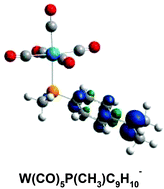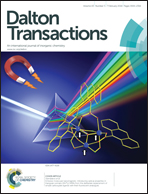Electronic structure predictions of the properties of non-innocent P-ligands in group 6B transition metal complexes†
Abstract
Neutral group 6B (Cr, Mo, W) pentacarbonyl complexes M(CO)5-L possessing various P-ligands such as phosphines, phosphaalkenes, and phospha-quinomethanes can form radical cations and anions under redox conditions. There is significant interest in whether the radical site is localized on the metal or on a “non-innocent” ligand. Density functional theory was used to predict whether the radicals of the complexes behave as metal or ligand-centered radicals and whether these compounds could form in solution or as an ion pair with various oxidizing and reducing agents. The quinone-like ligands are predicted to be ligand centered radicals when they are anions and metal centered radicals when they are cations. The predicted reaction energies for single electron transfer (SET) reactions involving the quinone like ligands are negative or near thermoneutral for both radicals in polar solutions and as solid state ion pairs. The energetics of the SET reactions can be controlled by the nature of L, the nature of the oxidizing/reducing agent, and the solvent polarity. Such complexes could be used as flexible catalysts for single electron transfer reactions.


 Please wait while we load your content...
Please wait while we load your content...